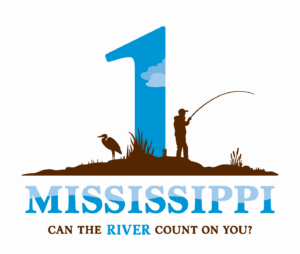What’s soil got to do with … rivers?
Last month, the Mississippi River Network hosted a webinar for its members and friends featuring Tim Wagner from the Izaak Walton League of America (an MRN member organization) and healthy soils policy and state legislation expert Steven Keleti. You can check out slides from Tim’s presentation and Steven’s presentation and watch the recording of the whole webinar on 1 Mississippi’s YouTube channel here.
10 Facts I Learned from Tim and Steven:
1. Healthier soils can save farmers money all while protecting our rivers from pollutants. Healthy soils can increase farm profits, reduce money spent on fertilizers, and require less water. This all translates into fewer potential pollutants entering our waterways and less excess fertilizer contributing to big environmental issues such as the Gulf Hypoxic Dead Zone.

Mississippi River Carrying Sediment Creating Algal Bloom in the Gulf of Mexico. Image shot 2007. Source: NASA/Landsat/Phil Degginger / Alamy Stock Photo
2. Sticky soil created the plow. Over two hundred years ago in 1819, farmland in Illinois cost only $1.25 per acre. The only catch was that most farming equipment (like the conventional plow) was built for the soils of the east – not the stickier soils of new frontiers like Illinois. As affordable land drew more farmers West, new tools were needed to be successful. A blacksmith in Illinois crafted a new tool, the self-polishing steel plow. This blacksmith was John Deere.
3. Technology, policies, and extreme weather all contributed to the Dust Bowl. John Deere’s new plow enabled farmers to till new land quickly and easily. A series of laws including 8 “Homestead Acts” and the New Deal encouraged 10 percent of land in the U.S. to become homesteads.
4. Healthy soils need roots. The Dust Bowl era taught us that what is happening below ground is just as important as what happens above ground. More often than not, we measure the productivity of land by what it produces above ground in the form of crops, but the Dust Bowl era demonstrated the importance of roots in the ground for healthy soil.
5. Beneficial microhabitats underground support plants and filter pollutants. A complex ecosystem exists below the soils surface. Many microbial and fungal microhabitats form mutually beneficial relationships with plants. These habitats not only feed plants, they also store carbon and water.
6. Healthy soils contribute to flood and drought resilience. Because of the beneficial habitats mentioned above, healthy soils are teeming with life – roots, microbes, fungi – that has the capacity to store carbon and water. In a flood situation, this means that healthy soil can filter pollutants and take-up excess flood water more quickly than degraded land. Healthy soil can also withstand the shocks of drought and reduce erosion.
7. Healthy soils legislation exists in many states. In fact, healthy soils legislation was on the docket or under consideration in all Upper Mississippi River basin states in 2019-2020.
8. Healthy soils legislation is most successful when it led by farmers and farm groups. Farmers are at the forefront of employing healthy soils practices, and their voices are important in conversations about policies and practices.
9. Healthy soils policy has widespread support. Healthy soils policy has bi-partisan/non-partisan support in many states, and legislation has been introduced by decision-makers and farmers representing both sides of the aisle.
10. It’s easy to get involved and learn more about legislation in your state. If you want to learn more about healthy soil legislation, you can join healthy-soils-legisla/on@googlegroups.com or check out healthysoilspolicy.org
-Maisah Khan
Policy Manager, Mississippi River Network
Can the River count on you? Become a River Citizen today!
Join our
COMMUNITY
And Get a Free E-book!
When you sign up as a River Citizen you’ll receive our newsletters and updates, which offer events, activities, and actions you can take to help protect the Mississippi River.
You’ll also get our free e-book, Scenes From Our Mighty Mississippi, an inspiring collection of images featuring the River.
Step 1
Become a River Citizen
Yes! The River can count on me!
I am committed to protecting the Mississippi River. Please keep me informed about actions I can take to protect the Mississippi River as a River Citizen, and send me my free e-book!, Scenes From Our Mighty Mississippi!
Step 2
LEARN ABOUT THE RIVER
We protect what we know and love. As a River Citizen, you’ll receive our email newsletter and updates, which offer countless ways to engage with and learn more about the River. You can also follow us on Instagram, Facebook, X (Twitter) , and YouTube, where we share about urgent issues facing the River, such as nutrient pollution, the importance of floodplains and wetlands, and bedrock legislation such as Farm Bill Conservation Programs.
Step 3
Take Action
There are many ways you can jump in and take action for a healthy Mississippi River. Our 10 actions list includes simple steps you can take at any time and wherever you are. Check out our action center for current action alerts, bigger projects we are working on, and ways to get involved.




